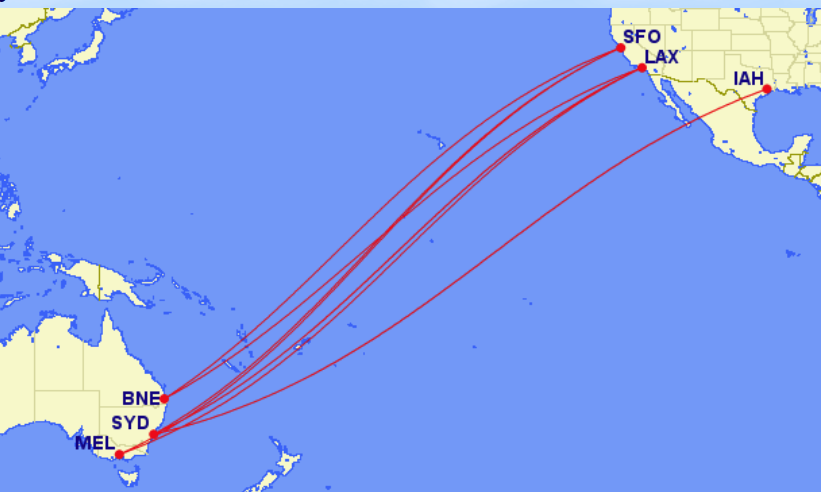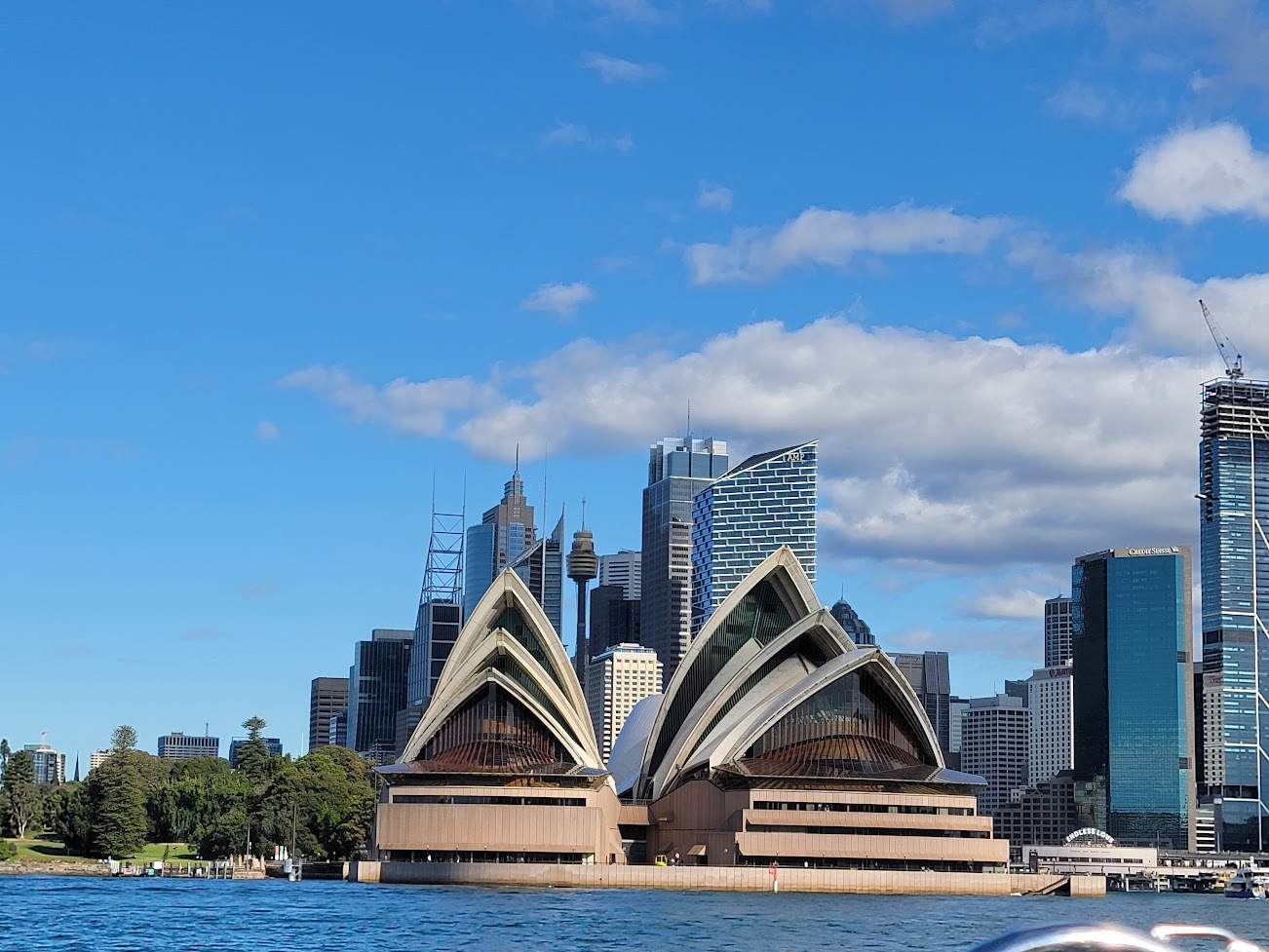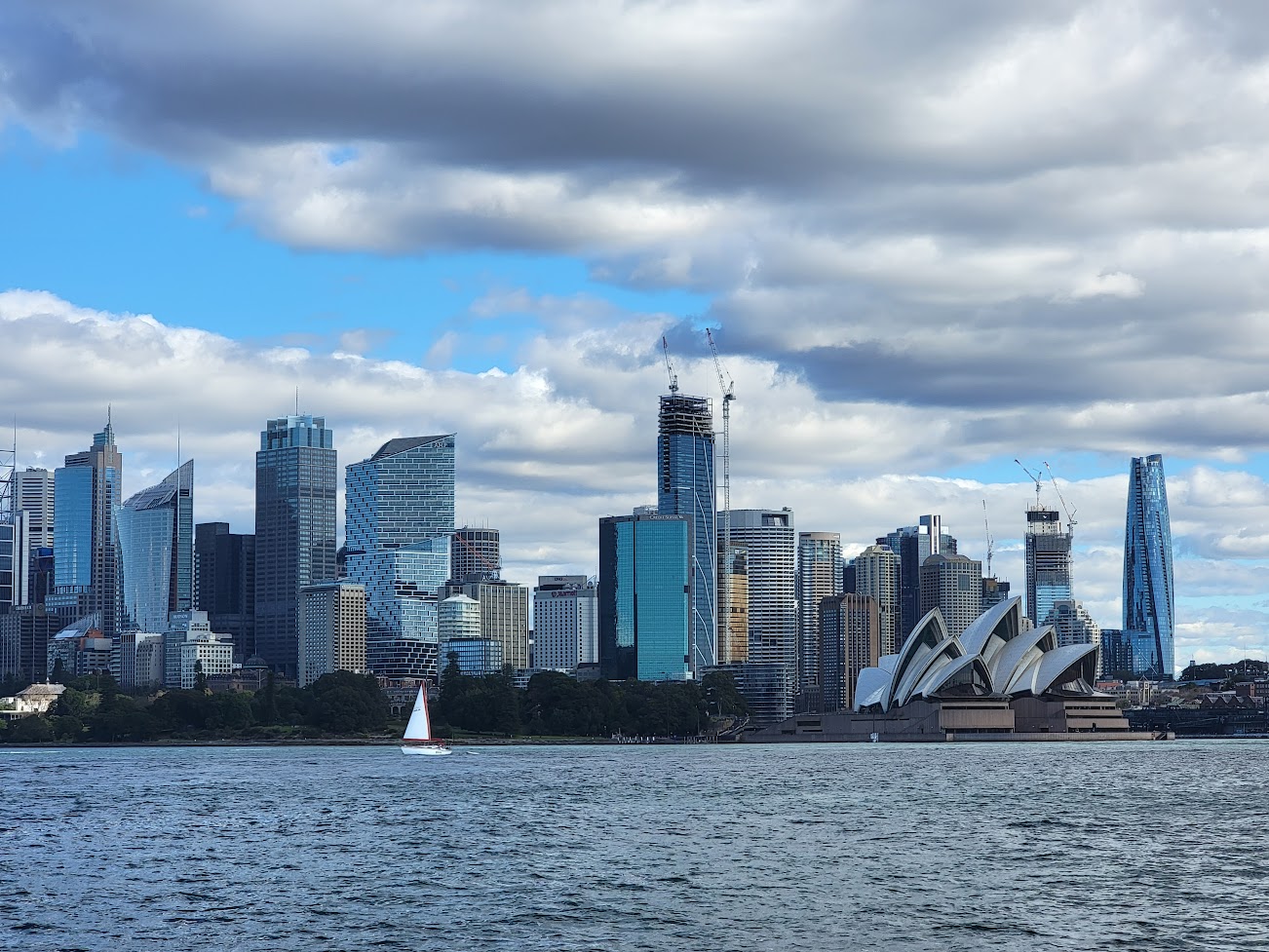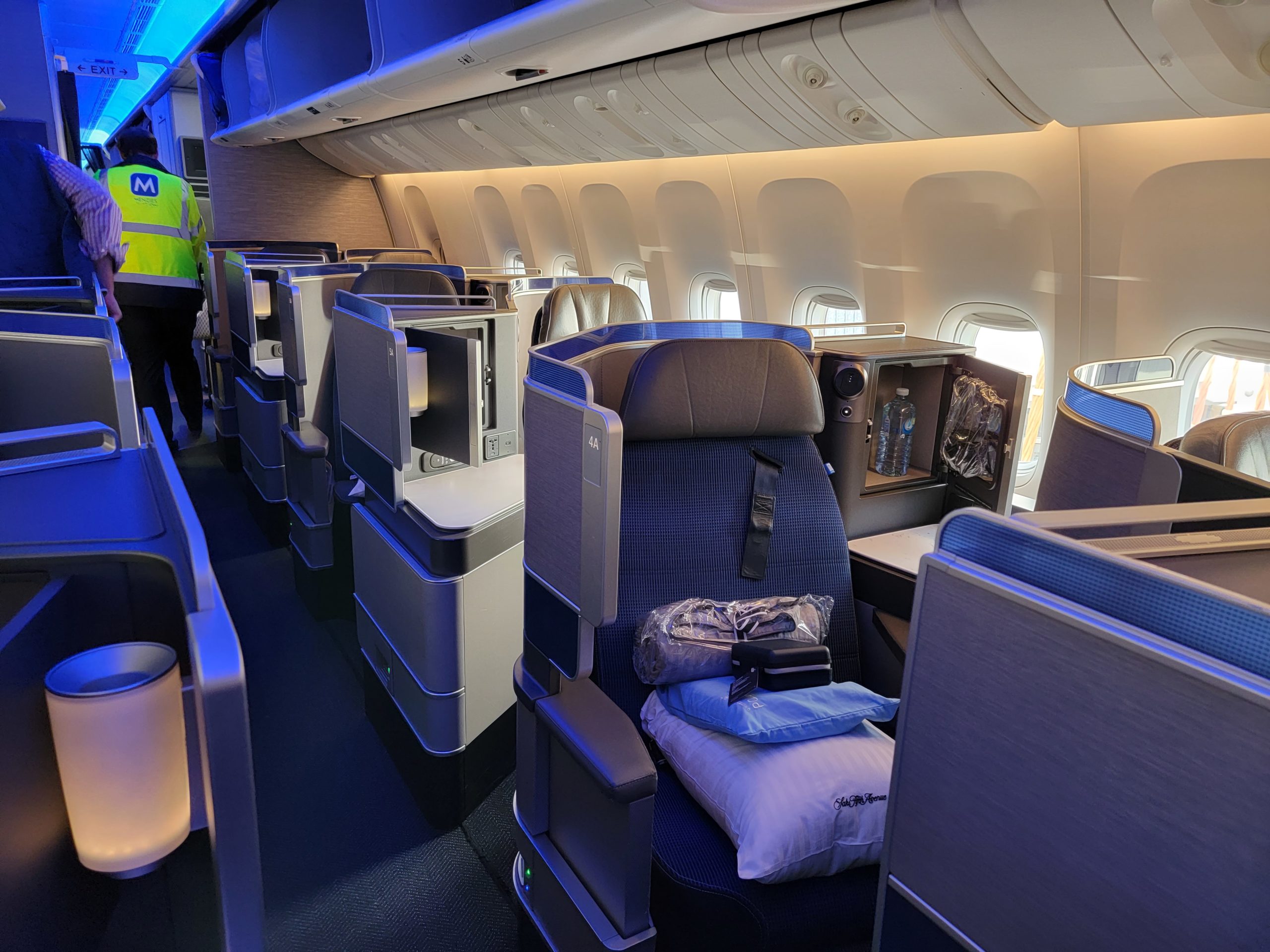Fifteen months ago United Airlines announced massive growth to Australia and New Zealand. They became the biggest airline to Australia, overtaking Qantas. And now, as first noted by aviation watchdog JonNYC, they are scaling back.
.. IAH-SYD reduced from 7x to 3x weekly in November and December
— JonNYC (@xJonNYC) July 26, 2024
Here is United’s route network to Australia – flying from Los Angeles and San Francisco to Sydney, Melbourne, and Brisbane and from Houston to Sydney.

United’s seasonal second flight between San Francisco and Sydney will only operate for two months, and only three days a week instead of daily. They’ll use a smaller plane for San Francisco to Melbourne, and there will be fewer LA – Melbourne flights leading into peak season. Houston to Sydney will also see fewer frequencies as well.
United gets domestic feed from Virgin Australia, which controls about one-third of Australia’s domestic flying compared to Qantas which controls two-thirds. Traditionally Australia has been a strong market for U.S. flying in winter and weak over the summer but post-Covid, summer flying has been strong as well.
However there’s been too much capacity added – especially to Brisbane which invested hundreds of millions subsidizing new United, American and Delta service. When those dollars run out we can expect further cuts.


The Chicago-based carrier remains larger to Australia than other rivals, and isn’t eliminating routes, but will fly either smaller planes or fly less frequently on several routes – removing seats from the market, hoping to fill remaining aircraft and at higher fares.
Interestingly they really haven’t made reasonable award seats available, certainly in premium cabins, on routes that are performing poorly. Australia is one of the toughest destinations for a premium cabin award.

American Airlines, for instance, was releasing reasonably-priced redemption seats a year ago as long as you weren’t flying non-stop. More recently they were releasing reasonably priced redemption seats for the first couple of weeks after a travel date loaded into their schedule. They’ve stopped doing this. Delta, of course, rarely releases reasonably-priced redemptions for long haul flights period. Air Canada’s Australia flights are exorbitant as well, and Qantas now releases premium cabin saver redemption inventory mostly to their own members and not to partner frequent flyer programs.
Paradoxically since it can be tough to get discounted premium seats to Australia, that might suggest the flights are doing well, and yet it does seem as though there isn’t enough demand to sustain all of the flying. That’s suggestive, perhaps, of a revenue management problem and not just a scheduling problem.


Australia thought it would flip a switch after it’s Chinese style Covid lockdowns and border closures and all would return to normal after crashing the economy and imprisoning it’s people. Human beings however, don’t work like that and like China, Australia has a massive post-lockdown hangover that is not quickly going away . . . particularly not with the current far-left Administration and despite a boom in the prices of mining commodities. After being stuck in or out of Australia and the rush in and out of Australia after the travel bans and restrictions were ended, demand has dried up again, pretty much as we’ve seen in Hong Kong and the rest of China.
Or alternatively….
UAL just doesn’t have the airplanes they need to fly all these routes. They were supposed to receive 9 787s from Boeing this year starting in Q2, and now they’ll be lucky if they get 2-3 planes by Q4. The difference in their planned schedule lines up with the missing aircraft.
Of course, they could have pulled capacity from Europe or Africa to make up the difference, so I suppose maybe Oz is underperforming those. It doesn’t necessarily mean Oz is underperforming in general though.
This is less about underperforming routes and more about not enough aircraft. These markets are doing fine but those larger shells can be used more efficiently at higher yields elsewhere. This is more a Boeing story than anything else.
I’m with Mac on this one. It amazed me that the rough and tumble outback people allowed themselves to tolerate a shut down of that magnitude! All for an exotic strain of the flu which the Chinese knew about before they released the Kraken.
This is not about aircraft availability. UA has the largest wide body fleet of the US3. The Australia and New Zealand markets were substantially over-served in peak 2023-2024 season and UA is the largest US carrier to the region. A lot of US-Australia traffic is driven from Australia POS and with a strong US dollar, there is likely less demand going into the Australian summer.
A lot of flights on US carriers were 50% full at best on some days last year. It was fairly easy to score an upgrade.
United doesn’t need 2 x daily on SFO-SYD.
As someone who frequently travels between Australia and the US, I find all this talk about the Australian economy being weak and driving this quite out of touch. The economy is going fine and they are still considering lifting interest rates while the US increasingly is facing calls to cut theirs earlier.
Also the “rough and tumble outback people” supported the shut downs, in doing so they saved thousands of lives.
Airlines have known the US-AUS routes have been over capacity for quite some time, though this does seem quite dramatic of cuts, I was expecting the SFO-SYD cut but not the LAX-MEL. These routes are also very popular for freight for UAL as well so even with less pax in the cabin they are often very profitable.
Interestingly, while UA partnered with VA, I’ve found they always list both QF and VA as same-priced options for connecting flights in Australia with their arriving flights from the US. I have no problem flying VA, but QF offers a few advantages. First, if connecting at SYD, QF has a better transfer service (“private” screening before you get on the bus vs, “public” afterward on VA). But, btw, if you can connect in SYD or MEL, choose MEL, as all their terminals are a short walk apart. Second, I hear QF has better lounges if you are J (been in QF’s not VA’s). Third, since I haven’t flown AA for years, I can get the miles I need to keep the account active. I have over 300K miles that I can’t ever seem to use to get anything J to Australia (or anything to Europe not through LHR on BA).
I have a flight next year BNE to USA, but given the subsidies BNE is giving, I feel that is safe.
I flew in 2023 and 2024 to Australia on Qantas A380 and American 777. Both planes were mostly full as far as I could tell. Tourists from the US dont care about Australia politics whatever they are. I think mos tpeople plan ultra long haul stuff a year out, maybe more. The past few trips I think the exchange rate has been about the same at 1.33 USd to AU. Prices are not cheap in the cities, although there are some hotel deals there at least when I go In May/June/July.
United dumped all kinds of capacity into the Pacific last winter and Cranky Flier documented how poorly much of it. Of course, United has no choice but to cut capacity since Delta managed to make money in the Pacific while United did not. United is run by business focused people and these decisions were inevitable
@Tim Dunn
Delta’s 4Q23 Pacific yield was 15.8c per mile and 1Q24 was 16.3c per mile
United’s 4Q23 Pacific yield was 16.5c per mile and 1Q24 was 16.9c per mile, while having a lower CASM-ex
I don’t think United made this choice because of Delta’s lackluster performance in the region. I think like most people said this is a yield optimization move – i.e. a decision made by “business focused people”.
Also United has distribution agreements with both Qantas (not a codeshare but still distributes through the QF website for US flights) and Virgin Australia, Delta’s partner is Rex… I think Delta is always going to be at a major disadvantage in the region – hence their poor performance.
One of these days I really hope to see you comment with some actual evidence to substantiate your illogical opinions.
when you price your product absurdly have bad food and a lesser premium cabin sorry but this is the end result
Tim Dunn,
DL did not do well on its routes to Australia and New Zealand either. It moved LAX-AKL to seasonal and dropped the second LAX-SYD, to run a subsidy padded LAX-BNE launching later this year.
Tim Dunn, Australia and New Zealand were an unmitigated disaster for Delta, and continue to be. The second largest and only other sizable airline in Australia besides QF, ditched Delta to team up with United. Delta has Rex. I don’t think I need to say anything else.
Once the BNE subsidies are done, DL will be left with a single LAX-SYD flight, meanwhile UA will still have YEAR ROUND flights to SYD, MEL, BNE, and AKL. DL could NEVER make AKL, MEL, or BNE work year round, meanwhile UA is year round to MEL from BOTH SFO and LAX.
So let’s not compare Delta, a very weak player in the Australia market, to the leader.
UA had a recent poor revenue outcome in the USA after changing their booking system to direct only. So if people wanted to use a travel agent, they were sol.
I flew back from USA in May, on United. The main cabin had so many empty seats that most of us had three seats to ourselves and pretty much all slept across our three seats. Best long haul flight I’d ever been on (apart from the food, which isn’t really edible). Sent my son a picture of “lunch” after my float over there. A salad roll. He said it looked like a sad sandwich. I told him it tasted sad.
Well, I think many of us said at the time that United’s huge expansion to AU last year was obvious overkill. Now, UAL is simply dialing back to reality, managing capacity… Move along; nothing to see here.
@Andy “the shut downs, in doing so they saved thousands of lives.”
You don’t have the slightest rational reason to believe this is true, and no evidence supports this statement. It is pure rationalization for self-harm. Despite harming ourselves – including most notably our children by closing schools – everybody in Australia (and around the world) has gotten Covid many times (most of us without even realizing it), yet almost all of us survived that usually minor ordeal, and there isn’t the slightest reason to believe that anybody was saved. On the other hand suicides and mental illness spiked and all Australians – like those in many similarly hysterical places – will forever be poorer, sadder, and less well educated than they otherwise would have been.
To be to see this happen,but what do you expect with the political games that are being played with by the airline companies themselves. They are pretty much screwing themselves with their corrupt selfishness
to no surprise, the United fankids are out in full force to try to defend UA and bash a competitor.
UA has been in the S. Pacific for decades while Delta is relatively new and AA has also been in the region for years but has yet to find its footing.
Airlines don’t report by route or by destination country. Anyone can make the charges they want about how well AA, UA or DL do in Australia or New Zealand but DL has had the highest margins for years.
Cranky Flier documented UA’s capacity dump into Asia/Pacific last winter and showed the load factors by destination. To no surprise, the cities where UA is cutting are in the S. Pacific and those were the worst performing by load factor.
Companies do not cut profitable routes. They just don’t.
All 3 US airlines cut capacity the most in the off-peak (US northern summer) months; UA is cutting capacity AND ROUTES in the peak northern winter 2024-25 from 2023-24
DL will still have 2 flights/day to Australia but now split between SYD and BNE.
DL says they will be serving MEL at some point in the future. UA knows that but still is reducing LAX-MEL. With 2 dozen A330NEOs and A350s coming in 2024 and 2025, DL will be growing Asia/Pacific.
UA saw its objective as to protect market share just as DL started to rebuild its Pacific and grow in the S. Pacific where it had never had large amounts of service.
UA’s strategy backfired and they are cutting.
The real question is where UA will deploy the capacity it was unable to make work last winter.
Some of us saw this coming a year ago and are not the least bit surprised that what we expected to happen is now happening.
@Mak
Your knowledge of Australia seems on par with your knowledge of India (i.e. non-existent)
@Tim
After having proclaimed that Delta’s 500K international biz class awards are a great deal and that Delta was going to take over the MidEast with it’s Riyadh Air Alliance, leading to peace, harmony and a goat in every pot, you now call others UA fanboys ?
@robertw “1.33 USd to AU” Huh? It is US$0.66 to AU$1. That’s AU$1.33 to $US1, but it makes a difference which is on top (so I’m told).
Brisbane seems to be growing market in general with a lot of people moving and travelling to South east Queensland. Qantas does not release many reward seats at all to their own frequent flyers and as an Australian who lives in Australia the lockdown was quite good as it was very free with limited limitations. Most things carried on as normal.
I’m a little late to this conversation but I’m surprised that @Tim Tim Dunn hasn’t mentioned Delta’s strategic partnership with REX after dumping Virgin Australia in the pandemic. Hooking up with REX is a an amazing long term win, perhaps the most amazing partnership ever. Delta is clearly playing five dimensional chess. REX has, oh wait, my calculator says ERR, when I calculate their market share in Australia. But I’m sure that’s part of the brilliant thinking of Delta. Always way ahead of us peons.